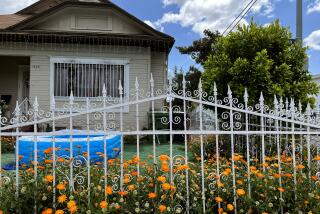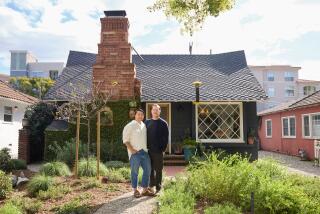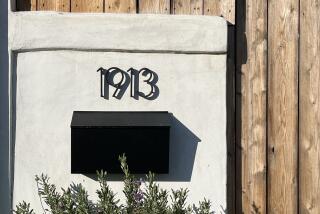LANDSCAPING : Soft Edges Seal the Invitation to Friendly Home
When considering a landscaping plan, you might find your tastes clash with those of your next-door neighbor, even if your homes are nearly identical. That’s because the tastes and lifestyle preferences of the owners do affect the decision-making process. Still, there are a few goal-specific rules and guidelines that should be applied to each site.
The first thing to consider is that the front of a home is different from the back, both physically and socially. For better or worse, the front yard is part of the larger community, while the back yard usually requires a private invitation.
The front is more formal, the back less so. In addition, front yards are often lopsided, with the house, garage, driveway or entry door uncomfortably weighted to one side. And finally, the fronts of houses are usually dominated by hard lines, as viewed from the street. The line separating the yard from the foundation, the door from the walk and the vertical corners from the horizontal lawn all produce abrupt, severe edges.
A front-yard landscaping plan, therefore, has several jobs to do. To begin, it must complement its surroundings--its neighborhood. Any striking departure from the norm should begin modestly near the street and then develop its full effect as it nears the house.
Above all, the front yard should be inviting, especially as you approach the front door. The plantings here should be chosen and placed so as to lead the visitor to the door and to focus attention there.
In addition to setting an inviting tone, these plantings should also break up the hard lines near the door. In practical terms, if the door waits at the end of a long walk, or driveway, the area near the door should be softened, to diminish that end-of-the-runway feel.
How are hard edges softened? By variety--specifically, by plants that vary in height, texture and color. The plantings near the door can be placed symmetrically, as when the sidewalk is centered on the property, or asymmetrically, as when the entry is off-center, right or left.
The same applies to a lopsided yard. If your house, garage or driveway hugs the left side, a prominent right-side grouping of plants can pull things back into balance. Similarly, the hard outside corners of a house can be obliterated by ornamental trees or shrubs, while the foundation line can be broken by shrubs, flowers and low-growing ground cover.
Side yards are transitional, both physically and visually. They either graft together the separate sensibilities of front yard and back yard, or they deliberately separate them. When a side yard is wide and spacious, shade trees and evergreens make good punctuation points and function as good dividers. When side yards are narrow, shrubs and flowers can lead the eye toward the back yard.
While front-yard sidewalks are usually made of concrete, side-yard and back-yard walkways can make good use of alternative materials.
Back yards are more casual. They can be cozy or structured. They can harbor Japanese gardens or sandboxes and tire swings. It all depends. If houses are like their owners, back yards are most like them. The plant selection should be less formal, with greater emphasis on variety and experimentation, and plant placement can be more relaxed--less orderly.
This is the place for wild clumps of tall grass, shade trees, vegetable gardens, fruited bushes, bird feeders, steppingstones, vine-covered arbors, a pool, horseshoe pits--it’s your call.






